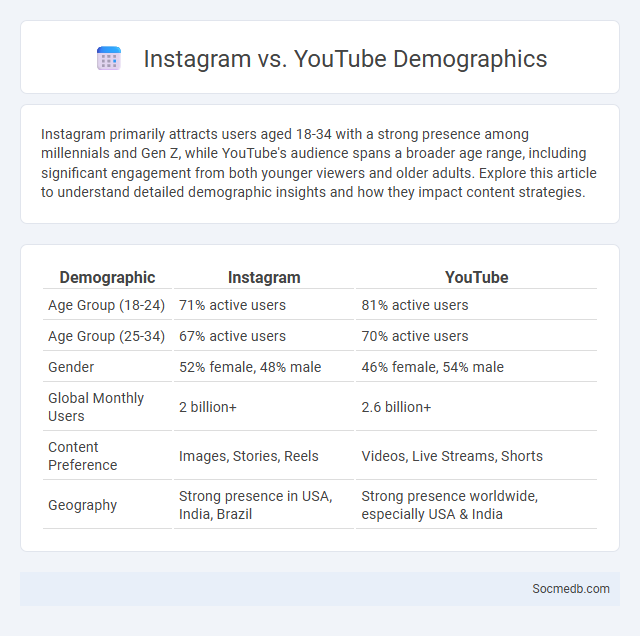
Photo illustration: Instagram vs YouTube demographics
Instagram primarily attracts users aged 18-34 with a strong presence among millennials and Gen Z, while YouTube's audience spans a broader age range, including significant engagement from both younger viewers and older adults. Explore this article to understand detailed demographic insights and how they impact content strategies.
Table of Comparison
| Demographic | YouTube | |
|---|---|---|
| Age Group (18-24) | 71% active users | 81% active users |
| Age Group (25-34) | 67% active users | 70% active users |
| Gender | 52% female, 48% male | 46% female, 54% male |
| Global Monthly Users | 2 billion+ | 2.6 billion+ |
| Content Preference | Images, Stories, Reels | Videos, Live Streams, Shorts |
| Geography | Strong presence in USA, India, Brazil | Strong presence worldwide, especially USA & India |
Overview of Instagram and YouTube User Demographics
Instagram attracts over 2 billion monthly active users, primarily aged 18 to 34, with a strong presence in urban areas and a balanced gender distribution. YouTube boasts more than 2.5 billion logged-in monthly users, with a diverse audience spanning all age groups, particularly popular among users aged 15 to 35. Both platforms demonstrate significant engagement, driving content consumption and influencing digital marketing strategies worldwide.
Age Distribution: Instagram vs YouTube
Instagram's age distribution primarily targets younger audiences, with approximately 67% of users aged 18-29, reflecting strong engagement among millennials and Gen Z. YouTube, while also popular with younger demographics, offers broader reach across all age groups, including significant usage by individuals aged 30-49 and even 50+. This diverse age distribution makes YouTube a versatile platform for advertisers aiming to connect with a wide demographic spectrum.
Gender Ratio Comparison
Recent studies reveal significant differences in gender ratio across various social media platforms, with platforms like Instagram and Pinterest showing a higher percentage of female users, often exceeding 60%, while LinkedIn and Twitter exhibit a more balanced or male-skewed user base, generally around 55% male. These disparities reflect differing content preferences and social interaction styles, influencing marketing strategies and content creation. Understanding platform-specific gender demographics enables businesses to tailor campaigns effectively and maximize user engagement.
Geographic Location and Regional Popularity
Social media platforms exhibit varying levels of popularity based on geographic location, with Facebook dominating North America and Europe, while platforms like WeChat and TikTok hold significant sway in Asia. Regional preferences are influenced by language, cultural trends, and government regulations, which shape user engagement and content consumption. Understanding these geographic and regional dynamics is crucial for targeted marketing strategies and platform localization efforts.
Education and Income Levels of Users
Social media usage varies significantly across education and income levels, with higher-educated and higher-income individuals exhibiting increased engagement on platforms such as LinkedIn and Twitter. Studies show that users holding a college degree are more likely to utilize social media for professional networking and educational content, enhancing their career prospects. Income levels also influence platform preference, as affluent users tend to invest in premium features and exclusive online communities, driving targeted advertising and revenue models.
Device Usage Patterns Among Demographics
Smartphone usage dominates social media access across all age groups, with 95% of millennials preferring mobile devices for platforms like Instagram and TikTok. Older adults, particularly those aged 55 and above, tend to use desktops or tablets more frequently, often engaging on Facebook or LinkedIn. Tablet usage peaks among middle-aged users during evenings, highlighting device preference variations influenced by demographic factors and time of day.
Content Preferences by Age and Gender
Content preferences on social media vary significantly by age and gender, with younger audiences gravitating towards short-form videos and interactive content, while older users prefer longer articles and news updates. Women are more likely to engage with lifestyle, fashion, and wellness content, whereas men often show higher interest in technology, sports, and gaming posts. Tailoring social media strategies to these demographic insights enhances engagement and drives targeted audience growth.
Engagement Rates Across Demographic Groups
Engagement rates on social media vary significantly across demographic groups, with younger users aged 18-24 demonstrating higher interaction levels through likes, comments, and shares compared to older age brackets. Platforms like Instagram and TikTok report peak engagement within Gen Z and Millennials, while Facebook serves a broader, more diverse age range with moderate engagement. Gender differences also reveal women typically exhibit higher engagement rates than men, particularly in lifestyle and beauty content niches.
Brand Influence: Marketing Insights by Platform
Social media platforms each offer unique opportunities for brand influence, with Instagram excelling in visual storytelling and influencer collaborations, while LinkedIn drives B2B engagement through professional networking and thought leadership content. Facebook's vast user base enables diverse demographic targeting and community building, whereas TikTok leverages short-form videos to capture younger audiences and boost viral brand visibility. Data analytics from these platforms reveal that tailored content strategies enhance customer loyalty, increase conversion rates, and optimize marketing ROI across different segments.
Future Trends in Instagram and YouTube Demographics
Instagram and YouTube are evolving rapidly with a growing emphasis on short-form video content appealing to Gen Z and Millennials, who dominate platform demographics. Enhanced AI-driven personalization will tailor feeds more precisely to your interests, increasing engagement and brand relevance. Brands leveraging these trends can expect improved reach among younger, digitally savvy audiences seeking authentic and interactive content experiences.
 socmedb.com
socmedb.com